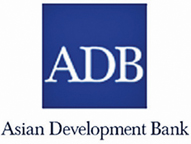'Developing Asia will maintain strong growth'
 Hong Kong, China - Developing Asia will maintain its strong economic
growth in 2015 and 2016 supported by soft commodity prices and recovery
in the major industrial economies, said a new Asian Development Bank (ADB)
report. Hong Kong, China - Developing Asia will maintain its strong economic
growth in 2015 and 2016 supported by soft commodity prices and recovery
in the major industrial economies, said a new Asian Development Bank (ADB)
report.
ADB's flagship annual economic publication, Asian Development Outlook
2015 (ADO), released recently forecasts that developing Asia will
achieve gross domestic product (GD) growth of 6.3% in both 2015 and
2016. The region also grew 6.3% in 2014. "Developing Asia is making a
strong contribution to global economic growth," said ADB Chief Economist
Shang-Jin Wei.
"Falling commodity prices are creating space for policy makers across
the region to cut fuel subsidies or initiate other structural reforms.
This is a key opportunity to built frameworks that will support more
inclusive and sustainable growth in the longer term," he said. From the
trough of the global financial crisis in 2009, developing Asia has
contributed 2.3 percentage points to global GDP growth - nearly 60% of
the world's annual 4.0% pace.
Eight economies in the region posted growth exceeding 7.0% in nearly
every year of the post-crisis period, including the People's Republic of
China (PRC), the Lao People's Democratic Republic and Sri Lanka.
Growth in the United States (US), where recovery seems to have turned
a corner, is leading major industrial economies. While signs are mixed
in the euro area and Japan, soft oil prices and accommodative monetary
policy will support growth. As a group, these economies are forecast to
expand by 2.2% in 2015, up 0.6 percentage points from 2014, and 2.4% in
2016.
With improving external demand for the region's outputs, an expected
pickup in India and in most members of the Association of Southeast
Asian Nations (ASEAN) could help balance gradual deceleration in the RPC,
the region's largest economy.
Growth slowed in the PRC in 2014 on weak fixed asset investment,
particularly in real estate. As the government proceeds with its
structural reform agenda, further slowing of investment is expected to
diminish growth to 7.2% in 2015 and 7.0% in 2016.
This is a much more moderate rate than the average growth of 8.5% in
the period since the global financial crisis. India is forecast to
overtake the PRC in terms of growth as the initial phase of government
efforts to remove structural bottlenecks is lifting investor confidence.
With the support of stronger external demand, India is set to expand by
7.8 % in FY2015 (ending March 31, 2016), a sharp rise from 7.4% growth
in FY2014. This momentum is expected to build to 8.2% growth in FY2016,
aided by expected easing of monetary policy and a pickup in capital
expenditure.
Financial systems in developing Asia have improved in the past decade
but further deepening of banks and capital markets and greater access to
finance is essential to enhance growth and equity in the region, the
report said.
Inclusive growth
"Improving the efficiency of the banking sector and capital market
can boost investment, productivity, and innovation," said ADB Chief
Economist Shang-Jin Wei.
"Reducing the dominace of state-owned financial institutions and
developing local currency bond markets are some of the important steps
needed in promoting Asia's financial development," he said. Despite much
progress, developing Asia's financial systems still lag advanced
countries by a wide margin.
Bank deposits, for example, equal 60% of regional gross domestic
product (GDP), compared with an average of 110% among members of the
Organisation for Economic Cooperation and Development. Developing Asia
bond markets equal less than half of GDP, or about a third of the 140%
average in advanced economies.
Financing Asia's Future Growth, the special theme chapter in ADB's
Asian Development Outlook 2015 (ADO), said that boosting developing
Asia's average ratio to GDP of liquid liabilities - currency plus
checking and interest-bearing accounts in financial institutions - from
about 65% to 75% would add almost 0.4 percentage points to average
annual GDP growth per capita. "Data shows that financial development
does not necessarily lead to a reduction in income inequality", said Wei.
"It is, therefore, important to also pursue financial inclusion
policies - measures that can boost access to financial services by
low-income households and small and medium-sized enterprises," he said.
The empirical evidence in the ADB report suggests that, while
financial development tends to alleviate inequality in its early stages,
inclusive growth becomes more likely with concerted government efforts
to improve financial inclusion. |

